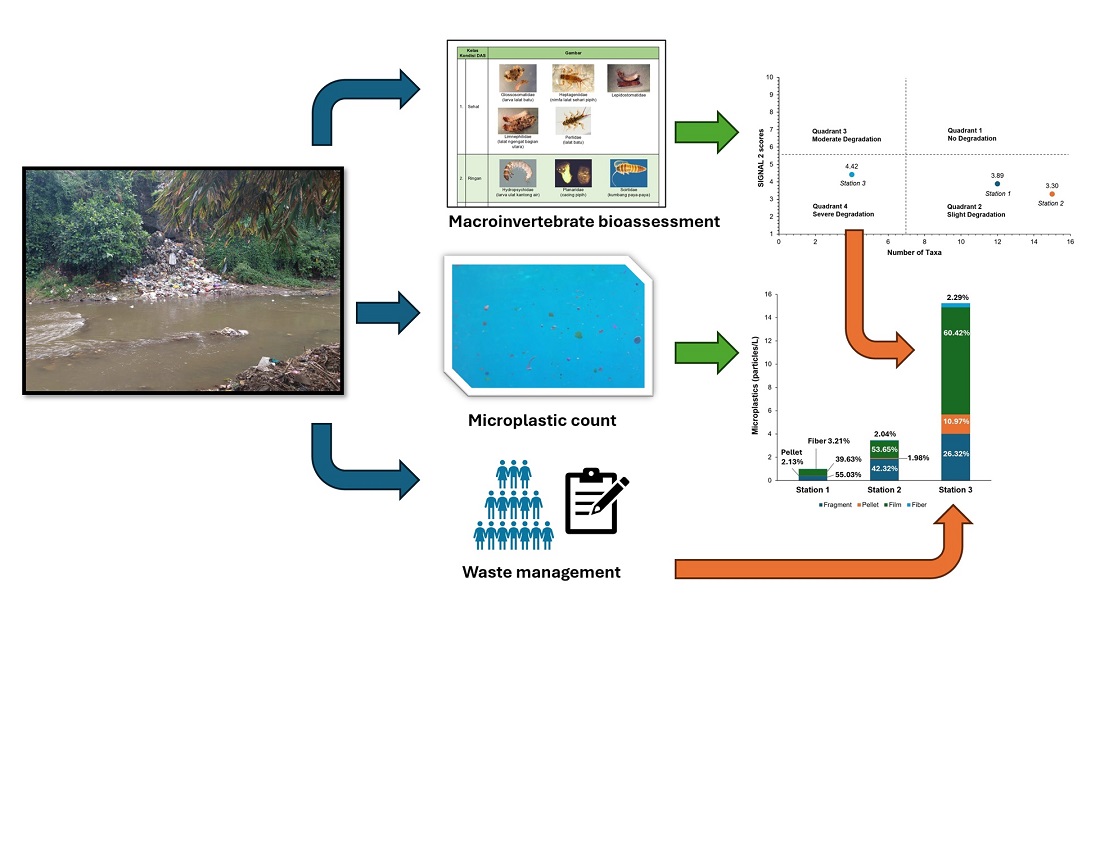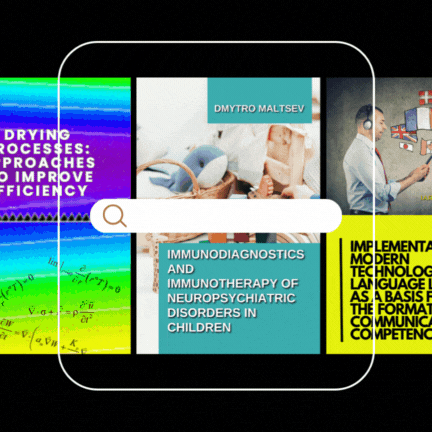Identifying the distribution and source of riverine plastic waste contamination: case study of Brantas River in Malang city
DOI:
https://doi.org/10.15587/1729-4061.2024.313830Keywords:
riverine microplastic, macroinvertebrate SIGNAL-2 index, waste management, domestic plastic waste, small-scale industry wasteAbstract
Brantas River experiences significant pollution due to domestic and industrial wastes. This condition also causes natural disasters such as floods. Single use plastics generally made up a large portion of local wastes. However, previous studies mostly investigated plastic waste pollution and local waste management habits as separate topics. Therefore, the objects of this study are the plastic wastes in Brantas River, as microplastic particles, and the identification of its source. The assessments were based on microplastic counts, macroinvertebrate bioassessment with SIGNAL-2 index, and the quantitative data of local domestic waste management at three Stations in Malang City area. Riverine microplastic pollutant concentrations and its sources were both successfully identified and solved. The results showed that the highest riverine microplastic particles were found in Station 3. This station only had four macroinvertebrate taxa with a SIGNAL-2 score of 4.42, indicating severe degradation. Quantitative data showed that 80 % of Station 3 residents threw plastic wastes directly to Brantas River. The low macroinvertebrate counts possibly caused by ingestion of microplastic from households and small-scale enterprises which heavily utilized single use plastics to trade their goods. The first distinctive feature of this study is the comparability of the microplastic, and macroinvertebrate counts with the river degradation status. Secondly, the quantitative data can serve as complementary evidence. Practically, the obtained results can be developed into an integrated plastic waste management plan for the residents surrounding the rivers, particularly in developing countries with similar socio-cultural conditions as elaborated in this study, to maintain the ecosystem quality
Supporting Agency
- The authors are deeply grateful for the support and generous knowledge sharing by the experts in Aquatic Resources Management Study Program, Faculty of Fisheries and Marine Sciences of Brawijaya University.
References
- Anggayasti, W. L., Salamah, L. N., Rizkymaris, A., Yamamoto, T., Kurniawan, A. (2023). The role of ion charge density and solubility in the biosorption of heavy metals by natural biofilm matrix of polluted freshwater: the cases of Mg(II), Cr(VI), and Cu(II). Environmental Pollutants and Bioavailability, 35 (1). https://doi.org/10.1080/26395940.2023.2220571
- Kurniawan, A. A., Sunardi, Hendarmawan, Ridwansyah, I. (2024). Evaluation of Watershed Carrying Capacity on Flood Management in Greater Malang East Java Indonesia. Revista de Gestão Social e Ambiental, 18 (3), e07378. https://doi.org/10.24857/rgsa.v18n3-155
- Sudaryanti, S. (2020). Makroinvertebrata untuk indikator perencanaan pengelolaan sub daerah aliran Sungai Brantas hulu wilayah Kota Batu. Universitas Brawijaya.
- Sudaryanti, S. (2021). Makroinvertebrata bentik untuk bioassessment kesehatan daerah aliran sungai (DAS). Malang.
- Elias, J. D., Ijumba, J. N., Mgaya, Y. D., Mamboya, F. A. (2014). Study on Freshwater Macroinvertebrates of Some Tanzanian Rivers as a Basis for Developing Biomonitoring Index for Assessing Pollution in Tropical African Regions. Journal of Ecosystems, 2014, 1–8. https://doi.org/10.1155/2014/985389
- Anggayasti, W. L. (2024). Local Perception and Behavior in Domestic Waste Management and Water Quality of The Brantas River, Dinoyo Ward. Jurnal Pembangunan Dan Alam Lestari, 15 (2). https://doi.org/10.21776/ub.jpal.2024.015.02.04
- Echendu, A. J. (2023). Flooding and Waste Disposal Practices of Urban Residents in Nigeria. GeoHazards, 4 (4), 350–366. https://doi.org/10.3390/geohazards4040020
- Asmaranto, R., Fidari, J. S., Sari, R. R., Pramesti, M. Y. (2024). Storm water management model to evaluate urban inundation in Lowokwaru and Blimbing sub-catchments in the city of Malang. IOP Conference Series: Earth and Environmental Science, 1311 (1), 012063. https://doi.org/10.1088/1755-1315/1311/1/012063
- Syaiful, A., Dermawan, V., Purwati, E. (2023). Study of Flood Control Due To Land Use Change at the Estuary of Bang River, Malang. Jurnal Teknik Pengairan, 14 (2), 114–124. https://doi.org/10.21776/ub.pengairan.2023.014.02.2
- Setyaningsih, W., Hadiyanto, H., Triadi Putranto, T. (2023). Microplastic Pollution in Indonesia: The Contribution of Human Activity to the Abundance of Microplastics. E3S Web of Conferences, 448, 03073. https://doi.org/10.1051/e3sconf/202344803073
- Salamah, L. N., Al-Zamzami, I. M., Pramudia, Z., Susanti, Y. A. D., Dhea, L. A., Kurniawan, A. (2024). Distribution of microplastics in Lusi Island, Sidoarjo, Indonesia. IOP Conference Series: Earth and Environmental Science, 1328 (1), 012012. https://doi.org/10.1088/1755-1315/1328/1/012012
- Sudaryanti, S., Herawati, E. Y. (2024). The river health of Alista River based on macroinvertebrates communities at Selorejo Village Dau Subdistrict Malang Regency. IOP Conference Series: Earth and Environmental Science, 1328 (1), 012008. https://doi.org/10.1088/1755-1315/1328/1/012008
- Stitz, L., Fabbro, L., Kinnear, S. (2013). Macroinvertebrate tolerance across a range of conductivities in the Isaac River catchment (Central Queensland). Australasian Institute of Mining and Metallurgy.
- Noor, S., Tajik, O., Golzar, J. (2022). Simple Random Sampling. International Journal of Education & Language Studies, 1 (2), 78–82. https://doi.org/10.22034/ijels.2022.162982
- Wang, X., Cheng, Z. (2020). Cross-Sectional Studies. Chest, 158 (1), S65–S71. https://doi.org/10.1016/j.chest.2020.03.012
- Ebere, E. C., Wirnkor, V. A., Ngozi, V. E., Chukwuemeka, I. S. (2019). Macrodebris and microplastics pollution in Nigeria: first report on abundance, distribution and composition. Environmental Analysis Health and Toxicology, 34 (4), e2019012. https://doi.org/10.5620/eaht.e2019012
- Kovač Viršek, M., Palatinus, A., Koren, Š., Peterlin, M., Horvat, P., Kržan, A. (2016). Protocol for Microplastics Sampling on the Sea Surface and Sample Analysis. Journal of Visualized Experiments, 118. https://doi.org/10.3791/55161
- Belqat, B., Afzan, H. (2015). Faunistic and bibliographical inventory of the Psychodinae moth-flies of North Africa (Diptera, Psychodidae). ZooKeys, 558, 119–145. https://doi.org/10.3897/zookeys.558.6593
- DeWalt, R. E., Resh, V. H., Hilsenhoff, W. L. (2010). Diversity and Classification of Insects and Collembola. Ecology and Classification of North American Freshwater Invertebrates, 587–657. https://doi.org/10.1016/b978-0-12-374855-3.00016-9
- Gerhardt, A., de Bisthoven, L. J. (1995). Behavioural, developmental and morphological responses of Chironomus gr. thummi larvae (Diptera, Nematocera) to aquatic pollution. Journal of Aquatic Ecosystem Health, 4 (3), 205–214. https://doi.org/10.1007/bf00116655
- Glasby, C. J., Erséus, C., Martin, P. (2021). Annelids in Extreme Aquatic Environments: Diversity, Adaptations and Evolution. Diversity, 13 (2), 98. https://doi.org/10.3390/d13020098
- Anggayasti, W. L., Satrio N., W., Wardana, I. N. G., Kurniawan, A. (2022). The mechanism of pH recalibration by dissolved oxygen in alkaline modified aquaculture seawater. Eastern-European Journal of Enterprise Technologies, 5 (10 (119)), 6–13. https://doi.org/10.15587/1729-4061.2022.266012
- Rico-Sánchez, A. E., Rodríguez-Romero, A. J., Sedeño-Díaz, J. E., López-López, E., Sundermann, A. (2022). Aquatic macroinvertebrate assemblages in rivers influenced by mining activities. Scientific Reports, 12 (1). https://doi.org/10.1038/s41598-022-06869-2
- Hertika, A. M. S., Sudaryanti, S., Musa, M., Amron, K., Putra, R. B. D. S., Alfarisi, M. A. et al. (2024). Benthic macroinvertebrates as bioindicators to detect the level of water pollution in the upstream segment of Brantas River Watershed in Malang, East Java, Indonesia. Biodiversitas Journal of Biological Diversity, 25 (2). https://doi.org/10.13057/biodiv/d250222
- Muntalif, B. S., Chazanah, N., Ilmi, F., Sari, N. E., Bagaskara, S. W. (2023). Distribution of the riverine benthic macroinvertebrate community along the citarum cascading dam system in West Java, Indonesia. Global Ecology and Conservation, 46, e02580. https://doi.org/10.1016/j.gecco.2023.e02580
- Pathak, G., Nichter, M., Hardon, A., Moyer, E., Latkar, A., Simbaya, J. et al. (2023). Plastic pollution and the open burning of plastic wastes. Global Environmental Change, 80, 102648. https://doi.org/10.1016/j.gloenvcha.2023.102648
- Zakiah, Riani, E., Taryono, Cordova, M. R. (2024). Microplastic contamination in water, sediment, and fish from the Kahayan River, Indonesia. Chemistry and Ecology, 40 (6), 697–720. https://doi.org/10.1080/02757540.2024.2357205
- Windsor, F. M., Tilley, R. M., Tyler, C. R., Ormerod, S. J. (2019). Microplastic ingestion by riverine macroinvertebrates. Science of The Total Environment, 646, 68–74. https://doi.org/10.1016/j.scitotenv.2018.07.271
- Parker, B., Andreou, D., Pabortsava, K., Barrow, M., Green, I. D., Britton, J. R. (2022). Microplastic loads within riverine fishes and macroinvertebrates are not predictable from ecological or morphological characteristics. Science of The Total Environment, 839, 156321. https://doi.org/10.1016/j.scitotenv.2022.156321
- Redondo-Hasselerharm, P. E., Falahudin, D., Peeters, E. T. H. M., Koelmans, A. A. (2018). Microplastic Effect Thresholds for Freshwater Benthic Macroinvertebrates. Environmental Science & Technology, 52 (4), 2278–2286. https://doi.org/10.1021/acs.est.7b05367

Downloads
Published
How to Cite
Issue
Section
License
Copyright (c) 2024 Wresti L. Anggayasti, Sri Sudaryanti, Maya Pertiwi, R. S. Fitriah Nurjannah, Tsamara Yona Sheviyandini, Jaka Suryatama, Renung Rubiyatadji, Maharani Pertiwi Koentjoro, Andi Kurniawan

This work is licensed under a Creative Commons Attribution 4.0 International License.
The consolidation and conditions for the transfer of copyright (identification of authorship) is carried out in the License Agreement. In particular, the authors reserve the right to the authorship of their manuscript and transfer the first publication of this work to the journal under the terms of the Creative Commons CC BY license. At the same time, they have the right to conclude on their own additional agreements concerning the non-exclusive distribution of the work in the form in which it was published by this journal, but provided that the link to the first publication of the article in this journal is preserved.
A license agreement is a document in which the author warrants that he/she owns all copyright for the work (manuscript, article, etc.).
The authors, signing the License Agreement with TECHNOLOGY CENTER PC, have all rights to the further use of their work, provided that they link to our edition in which the work was published.
According to the terms of the License Agreement, the Publisher TECHNOLOGY CENTER PC does not take away your copyrights and receives permission from the authors to use and dissemination of the publication through the world's scientific resources (own electronic resources, scientometric databases, repositories, libraries, etc.).
In the absence of a signed License Agreement or in the absence of this agreement of identifiers allowing to identify the identity of the author, the editors have no right to work with the manuscript.
It is important to remember that there is another type of agreement between authors and publishers – when copyright is transferred from the authors to the publisher. In this case, the authors lose ownership of their work and may not use it in any way.









